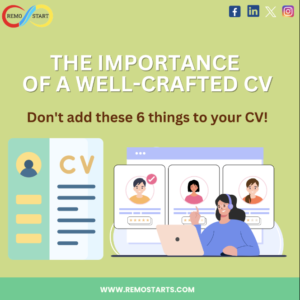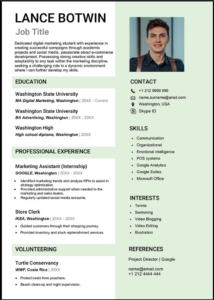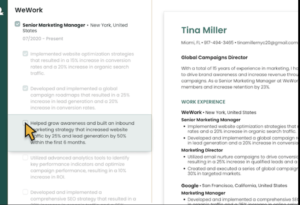As an experienced human writer, I understand the importance of a well-crafted CV in today’s competitive job market. Your curriculum vitae (CV) is the first impression you make on potential employers, and it can make or break your chances of securing an interview. In this comprehensive guide, I’ll share my insights on how to craft an impressive CV that showcases your unique skills, experiences, and professional potential.
Contents
- 1 The Importance of a Well-Crafted Curriculum Vitae
- 2 Understanding the Purpose of a CV
- 3 Key Elements of a Strong Curriculum Vitae
- 4 Different Types of CV Formats
- 5 Tips for Writing an Attention-Grabbing CV Summary
- 6 Showcasing Your Skills and Achievements in the CV
- 7 How to Effectively Highlight Your Work Experience
- 8 Including Relevant Education and Certifications in Your CV
- 9 The Role of Keywords in Optimizing Your CV for ATS
- 10 CV Design and Formatting Tips
- 11 Tailoring Your CV for Specific Job Applications
- 12 Proofreading and Editing Your CV for Perfection
- 13 CV Writing Services and Tools
- 14 Finalizing Your CV and Preparing for Job Applications
- 15 Conclusion: Take Charge of Your Professional Future with an Impressive CV
The Importance of a Well-Crafted Curriculum Vitae
Your CV is more than just a list of your work history and qualifications – it’s a powerful tool that can help you stand out from the crowd. A well-crafted CV can open doors to new opportunities, demonstrate your value to potential employers, and ultimately, help you achieve your career goals. By investing time and effort into creating an impressive CV, you’re taking a crucial step towards unlocking your professional potential.

Understanding the purpose of a CV
Understanding the Purpose of a CV
The primary purpose of a CV is to provide a concise and comprehensive overview of your professional background, skills, and achievements. It serves as a marketing document that highlights your unique value proposition and persuades employers to consider you for a specific role. Crafting an effective CV requires a deep understanding of the job market, the employer’s needs, and your own strengths and accomplishments.
Key Elements of a Strong Curriculum Vitae
A strong CV should include the following key elements:
- Contact Information: Your name, address, phone number, and email address should be prominently displayed at the top of your CV.
- Professional Summary: A concise, attention-grabbing summary that showcases your key strengths, relevant experience, and career aspirations.
- Work Experience: A chronological listing of your professional history, including your job titles, employers, and a brief description of your responsibilities and achievements.
- Skills and Expertise: A comprehensive list of your technical, interpersonal, and transferable skills that are relevant to the job you’re applying for.
- Education and Certifications: Details of your academic qualifications, including degrees, diplomas, and any relevant certifications or training.
- Additional Sections: Depending on your industry and career stage, you may also include sections for publications, awards, volunteer work, or other relevant information.
Different Types of CV Formats
There are several different CV formats to choose from, each with its own strengths and applications. The most common formats include:
- Chronological CV: This format focuses on your work experience, listing your jobs in reverse chronological order. It’s a popular choice for those with a consistent career progression.
- Functional CV: This format emphasizes your skills and accomplishments, rather than your work history. It’s often used by career changers or those with gaps in their employment.
- Combination CV: As the name suggests, this format combines elements of both the chronological and functional CV, highlighting both your work experience and your key skills.
The choice of format will depend on your specific circumstances and the requirements of the job you’re applying for. It’s essential to select the format that best showcases your strengths and aligns with the employer’s expectations.
Tips for Writing an Attention-Grabbing CV Summary
Your CV summary is the first thing a potential employer will read, so it’s crucial to make a strong impression. Here are some tips for crafting an attention-grabbing summary:
- Keep it Concise: Your summary should be no more than 3-4 lines, providing a high-level overview of your professional background and key strengths.
- Highlight Your Unique Value: Focus on the specific skills, experiences, and accomplishments that make you the ideal candidate for the role.
- Tailor it to the Job: Customize your summary for each job application, ensuring it aligns with the employer’s requirements and showcases your relevant qualifications.
- Use Powerful Language: Choose action-oriented verbs and compelling language to convey your value proposition and professional achievements.
Showcasing Your Skills and Achievements in the CV
Your CV should not only list your job responsibilities but also highlight your key achievements and the impact you’ve made in your previous roles. This can include:
- Quantifiable achievements (e.g., “Increased sales by 25% in the first quarter”)
- Specific projects or initiatives you’ve led or contributed to
- Awards, recognition, or commendations you’ve received
- Unique skills or expertise that set you apart from other candidates
By showcasing your accomplishments and the value you’ve brought to your employers, you’ll demonstrate your capabilities and potential to the hiring manager.
How to Effectively Highlight Your Work Experience
When presenting your work experience, focus on the following:
- Job Titles and Employers: List your job titles and employers in reverse chronological order, providing a clear overview of your career progression.
- Responsibilities and Achievements: For each role, describe your key responsibilities and achievements, using concise, action-oriented language.
- Quantifiable Results: Whenever possible, quantify your accomplishments to demonstrate the impact you’ve had (e.g., “Increased customer satisfaction by 15% through the implementation of a new customer service program”).
- Relevance to the Role: Tailor the information you include to the specific job you’re applying for, highlighting the most relevant experiences and skills.
By effectively highlighting your work experience, you’ll give the hiring manager a clear understanding of your capabilities and how you can contribute to their organization.
Including Relevant Education and Certifications in Your CV
Your educational background and any relevant certifications or training can also play a significant role in your CV. When including this information, focus on:
- Degrees and Diplomas: List your academic qualifications in reverse chronological order, including the institution, degree/diploma, and graduation year.
- Relevant Coursework: If you have completed any coursework or modules that are directly relevant to the job you’re applying for, be sure to include them.
- Certifications and Training: Highlight any professional certifications, licenses, or specialized training you’ve obtained, as these can demonstrate your commitment to continuous learning and development.
By showcasing your educational and professional development achievements, you’ll reinforce your qualifications and demonstrate your dedication to your field.
The Role of Keywords in Optimizing Your CV for ATS
Many employers use Applicant Tracking Systems (ATS) to screen and filter job applications. These systems rely on keyword-based searches to identify the most relevant candidates. To ensure your CV is optimized for ATS, incorporate relevant keywords throughout your document, including:
- Job-specific skills and expertise
- Industry-specific terminology and acronyms
- Relevant software, tools, and technologies
- Key accomplishments and achievements
By strategically incorporating these keywords, you’ll increase the chances of your CV being selected for further review by the hiring manager.

CV
CV Design and Formatting Tips
While the content of your CV is crucial, the design and formatting also play a significant role in creating a professional and visually appealing document. Consider the following tips:
- Clean and Consistent Layout: Use a clear, easy-to-read font, consistent spacing, and well-organized sections to ensure your CV is visually appealing and easy to navigate.
- Strategic Use of Headings and Formatting: Utilize headings, bullet points, and other formatting techniques to highlight key information and make your CV more skimmable.
- Appropriate Length: Aim for a CV that is one to two pages in length, ensuring you include only the most relevant and impactful information.
- Consistent Branding: If applicable, incorporate elements of your personal brand, such as a consistent color scheme or logo, to create a cohesive and memorable impression.
By paying attention to the design and formatting of your CV, you’ll create a document that is not only informative but also visually appealing and easy to read.
Tailoring Your CV for Specific Job Applications
To maximize your chances of success, it’s essential to tailor your CV for each job application. This involves:
- Researching the Employer: Thoroughly research the company, its values, and the specific requirements of the role you’re applying for.
- Customizing Your Content: Adapt the content of your CV to highlight the skills, experiences, and achievements that are most relevant to the job description.
- Aligning with the Job Requirements: Ensure that your CV directly addresses the employer’s needs and demonstrates how you are the ideal candidate for the position.
By taking the time to tailor your CV for each job application, you’ll show the hiring manager that you’re genuinely interested in the role and have the necessary qualifications to succeed.
Proofreading and Editing Your CV for Perfection
Before submitting your CV, it’s crucial to carefully proofread and edit the document to ensure it is free of errors and typos. This includes:
- Checking for Spelling and Grammar: Carefully review your CV for any spelling or grammatical mistakes, as even small errors can negatively impact your professional image.
- Verifying Contact Information: Double-check that your contact details, such as your phone number and email address, are accurate and up-to-date.
- Ensuring Consistent Formatting: Review the formatting of your CV to ensure it is consistent throughout, with no inconsistencies in font, spacing, or alignment.
- Seeking Feedback: Consider asking a trusted friend, family member, or professional to review your CV and provide constructive feedback.
By taking the time to proofread and edit your CV, you’ll ensure that it is polished, professional, and ready to impress potential employers.

Tailoring Your CV for Specific Job Applications
CV Writing Services and Tools
If you’re feeling overwhelmed by the process of creating an impressive CV, consider utilizing the services of a professional CV writing service or exploring the various CV-building tools available online. These resources can provide valuable guidance, feedback, and templates to help you craft a standout CV that showcases your unique qualifications and potential.

CV Writing Services and Tools
Finalizing Your CV and Preparing for Job Applications
Once you’ve crafted your impressive CV, the final step is to prepare for your job applications. This may include:
- Saving Your CV in the Appropriate Format: Ensure your CV is saved in a commonly accepted format, such as PDF or Microsoft Word, to ensure it is easily accessible and viewable by potential employers.
- Organizing Your Application Materials: Gather any additional documents or information you may need to submit with your job applications, such as cover letters, references, or writing samples.
- Developing a Job Application Strategy: Determine the best approach for submitting your CV, whether it’s through an online application system, email, or direct outreach to the employer.
By taking the time to finalize your CV and prepare for your job applications, you’ll demonstrate your professionalism and increase your chances of securing an interview.
Ready to take the next step in your career? Let’s work together to craft an impressive CV that showcases your unique talents and unlocks your professional potential. Contact me today to learn more about my personalized CV writing services and how I can help you stand out from the competition.
Conclusion: Take Charge of Your Professional Future with an Impressive CV
Crafting an impressive CV is an essential step in taking charge of your professional future. By understanding the purpose of a CV, mastering the key elements of a strong CV, and incorporating strategic formatting and optimization techniques, you can create a document that effectively highlights your unique qualifications and value proposition.
Remember, your CV is not just a list of your work history and credentials – it’s a powerful tool that can open doors to new opportunities and help you achieve your career goals. By investing time and effort into creating an impressive CV, you’re taking a crucial step towards unlocking your professional potential and securing the job of your dreams.
